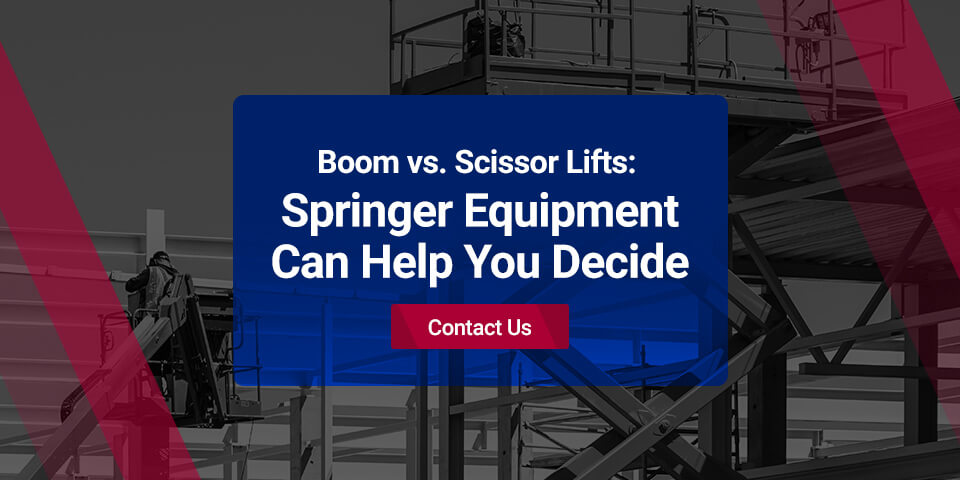Should you get a boom lift or scissor lift? If your jobs require working at heights, you’ll likely need either (or both) of these aerial work platforms at some point. Each equipment type enables you to perform various tasks at higher elevations — but in different ways.
In this post, we’ll explain the differences between a boom lift and a scissor lift, as well as the advantages and limitations of each.
What Is a Boom Lift?
A boom lift consists of a grounded base resting atop four wheels and an arm (boom) attached to a small bucket that typically holds one worker. The base features a turntable that rotates the boom. A hydraulic mechanism allows operators to raise and lower the arm as needed.
The two general types of boom lifts are:
- Telescopic: These lifts extend straight upward or outward, similar to a telescope. Their long reach (some models can raise the platform over 200 feet) makes them an excellent choice for projects like tree trimming or performing utility line repairs.
- Articulating: Although this boom lift has a lower lift capacity than telescopic versions (up to 150 feet), it offers additional flexibility. Articulating models have a bendable arm that can maneuver the bucket around obstacles, making them a good option for accessing hard-to-reach areas.
The benefits of choosing boom lifts over scissor lifts include greater lift capacity and maneuverability, which is essential when performing tasks at higher elevations. The lightweight and narrow design enable the grounded base to fit in tight spots. Plus, the extra maneuverability provided by articulating models offers more flexibility to perform a wider variety of tasks.
A potential boom lift drawback is the smaller bucket size, which limits the number of workers that can perform a job and the size and weight of the tools and materials they can carry to complete the project. Stability can also be an issue, especially when working on uneven or rugged terrain. From a cost perspective, boom lifts are usually more expensive than scissor lifts.
What Is a Scissor Lift?
A scissor lift consists of a four-wheel base and a large, flat platform resting on a crisscrossed bracing system that serves as the lifting mechanism. The braces extend to raise the platform, which can accommodate several workers and their supplies, and compress during lowering. Depending on the model, scissor lifts have a lift capacity of 10-60 feet.
The first difference you’ll notice when viewing a scissor lift and a boom lift is their appearance. The former features a compact design, while the latter resembles a smaller version of a crane.
Types of scissor lifts include:
- Electric: These battery-powered models do not contain internal combustion engines or emit noxious exhaust fumes, making them compatible with indoor projects. Use them on level surfaces to perform tasks such as window cleaning, indoor maintenance and general building repairs.
- Rough terrain: A rough terrain forklift can serve your needs for outdoor projects on uneven surfaces. Use this equipment for maintenance work and various applications at construction and industrial sites.
The advantages of scissor lifts include their large, stabilized platforms that can safely hold multiple workers — several pairs of hands can accomplish more work in less time. The indoor and outdoor models give you more choices when selecting the right version for your needs. Because scissor lifts are less expensive than boom lifts, they’re an easier fit for a company’s budget.
On the other hand, the lower height capacity of scissor lifts can disqualify them from jobs requiring more extensive reach. You also won’t have as much maneuverability to position workers where they can be the most productive, as you’ll need to place the lift next to the targeted work area.
What Is Better — a Boom or Scissor Lift?
In summary, the better choice between a boom and a scissor lift depends on your company’s needs. Base your decision on these factors:
- Reach: If you routinely work at elevations exceeding 60 feet, you’ll need a boom lift to get the job done.
- Stability: Do your crews work closer to the ground? A scissor lift provides extra steadiness and balance to keep several workers safe and increase productivity.
- Maneuverability: Consider a boom lift (especially an articulating model) if you require the flexibility to guide workers around obstacles.
- Cost: If funds are tight and your company is working with a limited budget, a scissor lift can usually provide a less expensive option.

Boom vs. Scissor Lifts: Springer Equipment Can Help You Decide
Are you still unsure if you need a boom or scissor lift? At Springer Equipment, we’ve been selling and servicing used aerial lifts, forklifts, and other essential equipment for over 30 years. Trust our expertise to help you make the right purchasing decision for your company. Contact us for more information today.

